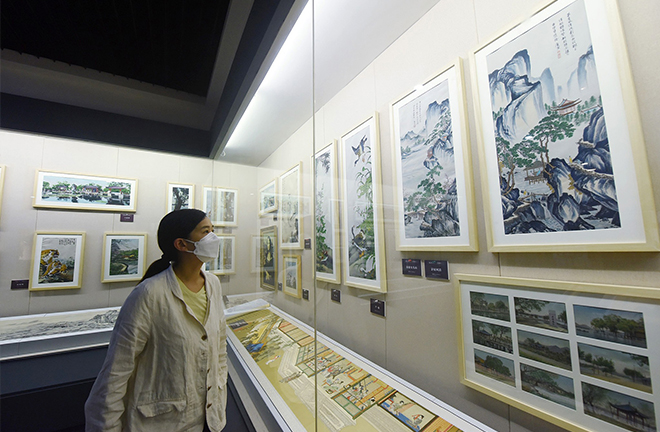Art history needs solid literature base

Famous Chinese paintings reproduced in textiles, exhibited at the Dujinsheng Silk Brocade Museum in Hangzhou, Zhejiang Province, on May 20 Photo: CFP
Chinese painting and calligraphy literature offers a logical starting point and research object for the history of Chinese fine arts. Systematically collecting, compiling, and researching the literature of Chinese painting and calligraphy, as well as exploring the intellectual content, historical concepts, and research methods therein, helps objectively restore the development history of Chinese fine arts and drive disciplinary development.
Literature base
In rich and diverse forms, historical Chinese painting and calligraphy literature has preserved both written works and visual images, including literature and classics concerning painters and calligraphers, painting and calligraphy works, painting and calligraphy activities, and more. According to Wang Hanwei, a professor from the School of Humanities at Tongji University, Chinese calligraphy and painting literature contains the creation ideas, techniques, and aesthetic concepts of calligraphers and painters, demonstrating their traditional authorship mode, academic attitude, and research methods, and reflecting the historical and cultural background, social ethos and phenomena, as well as social life. The compilation and research of Chinese calligraphy and painting literature not only involves the basic work of collecting, compiling, and collating ancient literature versions, distinguishing and investigating the content, and annotating the original meaning, but also includes the deep interpretation of theoretical value, thoughts and ideas, and social ethos therein.
Literature constitutes the foundation of researching the history of Chinese fine arts. The abundant literature on traditional Chinese paintings provides rich materials for the study of painting appreciation and collection history, concept history, and cultural history. Traditional painting and calligraphy theoretical literature also encompass rich aesthetic thoughts, embodying the general views and concepts of ancient Chinese on art and aesthetics. Fan Minghua, a professor from the School of Philosophy at Wuhan University, said that in the early history of painting, traditional Chinese calligraphy and painting literature had a decisive influence on the study of Chinese fine arts history. Without the Classified Record of Painters of Former Times by Xie He in the Southern Dynasties (420–589) and On Famous Paintings Through the Ages by Zhang Yanyuan in the Tang Dynasty (618–907), it would be inconceivable to study the fine arts of the Han (202 BCE–220), Wei (386–534), Jin (266–420), and Tang dynasties.
In the late history of painting, without the support of relevant literature, we can neither make clear the evolution of painting and calligraphy, nor understand the conceptual changes behind the phenomenon of painting and calligraphy, Fan continued. Without such literature as Friar Bitter-Melon on Painting and Dadizi’s Comments on His Own Poems Inscribed on Paintings by Shi Tao in the Qing Dynasty (1644–1911), it would be very difficult to deeply understand the philosophical and aesthetic implications of Shi Tao’s paintings.
From modern research of Chinese fine arts history, the advancement of certain literature research can even change our understandings of fine arts history. For example, Ruan Pu’s “Su Shi’s Views on Literati Painting” corrected our understanding of the development of literati painting in the Northern Song Dynasty (960–1127) through examining literature on Su Shi’s discussions of painting, Fan said.
Disciplinary construction
In the first half of the 20th century, along with the modern transformation of the Chinese academic culture system and the rise of fine arts history, art historians represented by Zheng Wuchang, Fu Baoshi, and Yu Shaosong led the trend of reviewing the development history of ancient Chinese painting and calligraphy with modern research methods. In the second half of the 20th century, many basic compilations of painting and calligraphy literature emerged. On the whole, scholars have had rich research results in terms of the compilation and collation of calligraphy and painting literature, as well as comprehensive sorting from the angles of historiography, art, and sociology.
Chinese painting and calligraphy literature has gradually formed a research mode combining history and theory, shaping a painting theoretical system under the background of Chinese culture. However, without establishing a complete discipline and finishing the basic work of collection, compilation, and collation, its depth and breadth still has a gap compared with philological research in literature, history, and philosophy, calling for further development, Wang said.
From the punctuation collating, annotation, and other compilation work concerning traditional Chinese literature, the painting and calligraphy field has an even bigger gap compared with literature, history, and philosophy, Fan said. The latter fields have produced considerable authoritative and widely used punctuation collating versions and annotation versions with an attribute of reference books, even forming special philology branches or historical data studies in alignment with their respective disciplines. However, in the field of painting and calligraphy, some of the core classical literature has not yet seen high-quality compilations, punctuation collating versions, and annotation versions, let alone general literature.
To boost compilation and research in the field, Wang suggested that, on the basis of the overall investigation of Chinese painting and calligraphy literature, case studies should be gradually conducted to systematically examine the changes in the history of Chinese fine arts in special historical periods, revealing the multiple interactions between art and society. Furthermore, it is necessary to integrate multidisciplinary perspectives, and forge academic features that combine history and theory and thread ancient and modern research, better serving the disciplinary construction of painting and calligraphy literature.
Edited by YANG LANLAN
